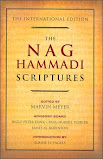History rhymes: it moves in cycles of growth, destruction and then further growth; we see intense conflict followed by loving peace, leading to complacency and the withering of what brought the beauty and success to begin with, only to give birth to something greater. Another common historical rhyme is that each age has a wealthy establishment which attempts to suppress information or people that threatens its control: Emperors, Tsars and tycoons. Any serious student of world history, mythology and ideas knows these things to be true.
The Nag Hammadi Scriptures have captured the imagination of seekers around the world because their story and content exemplify the points raised above. In brief, they represent a type of Christianity that flourished between approximately 70 AD to 400 AD but ceased to exist thereafter. They are called gnostic which generally means a direct knowledge of the truth. However, while they are diverse and defy being pinned down by a single word, these texts were lumped into a single category when a significant second century Catholic bishop named Irenaeus equated the term heretic with the word gnostic as part of the early attack on this style of Christian thought.
The maniacal siege on these Greek-Egyptian mystics reached its crescendo in 367 AD when Athanasius, the Archbishop of Alexandria, called for all texts outside of those acceptable to the political-religious establishment to be stolen and burned on the grounds they were heretical. Elaine Pagels’ succinct and important work The Gnostic Gospels does a great job in outlining the forces at play during the period. The indications are that once the great purge started the monks living in St Pachomius, in modern day Egypt, buried the Nag Hammadi collection for individuals to find in a more receptive period.
Flash forward to 1945. The second world war is complete, and the collective mind is ready for an opening of consciousness. The Nag Hammadi Scriptures were accidentally discovered by bandits on the run after avenging their father’s murder. When digging for soft soil to use as fertilizer they hit upon the red earthenware jar containing the texts. After attempted black market transactions, and subterfuge of various forms, the newly discovered Scriptures exploded into centres of learning in the 1960s. It was certainly the best time for them to arrive on the scene, as authority was being questioned in all directions, and people were becoming increasingly interested in cross-faith learning.
The Crown Jewel of the Nag Hammadi collection is in my opinion the Gospel of Thomas. This text is dated by experts, such as Helmet Koester, as being compiled in approximately 140 AD but written down and taught from between 50 AD to 100 AD. He suggests the Gospel may be even earlier than the four New Testament Gospels, Matthew, Mark, Luke and John. Upon reading the Gospel of Thomas, one notices two things: firstly, the intensely philosophical nature of the sayings, with some reading as if they were right out of the works of Plato; secondly, an occasional similarity to the ideas found in Buddhism. There is a school of thought that the Christians who followed the Gospel of Thomas interacted with Buddhist and Vedic scholars more broadly. It was around this time that trade routes between the Greco-Roman and the far East were beginning to flourish. Elaine Pagels notes that Hippolytus a Greek Christian wrote about Brahmanism in 235 AD.
To learn more about the Gospel of Thomas, my suggestion is you read or listen to it. Part of the charm of the text is how direct it is: you feel as if Jesus is talking straight at you due to it consisting of a series of wisdom sayings rather than being in the narrative form of the New Testament Gospels. Some of my favourite sayings from the text are:
“Jesus said, "If your leaders say to you, 'Look, the (Father's) kingdom is in the sky,' then the birds of the sky will precede you. If they say to you, 'It is in the sea,' then the fish will precede you. Rather, the (Father's) kingdom is within you and it is outside you.”
"The Pharisees and the scholars have taken the keys of knowledge and have hidden them. They have not entered nor have they allowed those who want to enter to do so. As for you, be as sly as snakes and as simple as doves.”
“Jesus said, "If they say to you, 'Where have you come from?' say to them, 'We have come from the light, from the place where the light came into being by itself...If they say to you, 'Is it you?' say, 'We are its children, and we are the chosen of the living Father.' If they ask you, 'What is the evidence of your Father in you?' say to them, 'It is motion and rest.'"
We are at another point of time where information is considered dangerous. This time the establishment acts within an international corporate, umbrella structure as outlined by the work of historian Carroll Quigley. I don’t agree with all the Nag Hammadi Scriptures, just like I don’t believe in all theories outside of what the establishment approves. Yet, to label and target anyone that thinks creatively or different to the norm is as foolish and dangerous now as it was in the early centuries of the Roman-Christian empire.
